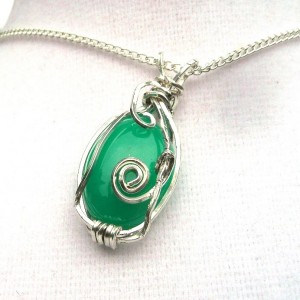- NEW DVD Series – Stone Setting with Bezels
- Tube Set Charm by Kim St. Jean
- Prong Basket Pendant by Kim St. Jean
- NEW DVD Series – Stone Setting with Cold Connections
- New DVD Series – Stone Setting with Wire
- NEW DVD Series: Introduction to Stone Setting by Kim St. Jean
- Featured Tool: Bracelet Bending Plier
- NEW Dvd by Eva Sherman
- Fun, Fast Fold Forming DVD Series
- Double Band Ear Cuff from Alex Simkin
Gem Profile June 29: Chrysoprase
by Rose Marion, Wire-Sculpture.com

Chrysoprase
Shop Chrysoprase Beads
Chrysoprase is the apple-green form of chalcedony, instantly recognizable by its color, which is caused by nickel. Chrysoprase can be opauque, semitransparent, and even slightly translucent. Chrysoprase is found in North America (including Arizona and California), Europe (including Poland, Germany, and Russia), and Australia, and has a Mohs hardness of 6-7. Demand for chrysoprase has fluctuated over time: Poland’s mines were popular until they played out around the 14th century. Chrysoprase was popular again in England in the 1800s until supply dried up again; high-quality chrysoprase was discovered in Queensland, Australia in 1965, bringing a new supply to the market.

Mary Jean Skiba wrapped this chrysoprase cabochon in a custom design for a friend: the friend had been told that the energy of chrysoprase could help her, and she wanted a spiral in the center to symbolize the spiral goddess.
Chrysoprase is named similarly to chrysocolla because they are both associated with gold: "chryso-" refers to gold in Greek. While chrysocolla, "gold glue," is named because of its similarity to an early gold soldering material, chrysoprase comes from the Greek for "gold green," although it can also translate to "golden leek," which pretty much describes the shades of green chrysoprase is found in. Darker varieties of chrysoprase are sometimes simply called "prase", although this is also used to describe a type of quartz with leek-green chlorite inclusions, which you can see here. Prase even referred to a type of green jasper in the past, although it’s no longer used that way in most places.
Real Chrysoprase
Chrysoprase is also called Australian Jade and spelled chrysophrase or chrysophase. Chrysoprase can be enhanced with dye, and even imitated with quartz impregnated with chrome green dyes. It is also easy to confuse some chrysoprase with jadeite, which is more rare than chrysoprase (and thus some suppliers label chrysoprase as jadeite). Some chrysoprase that is labeled as Chinese chrysoprase is actually simply serpentine. To tell if chrysoprase is real or manufactured, like many semiprecious stones, look for small inclusions and imperfections throughout the stone: if there are absolutely no inclusions, the stone is likely worth a lot, treated somehow, or an imitation.
Prase and Plasma
Plasma is also a variety of chalcedony with green coloring, but this color comes from not nickel, but other minerals like amphibole, celadonite, and chlorite. Plasma also features yellow and white coloration.
Chrysoprase in Culture
As far as the metaphysical value of chrysoprase, it is said to encourage hope, joy, ease restlessness, and even give protection when traveling on the ocean. Hildegarde von Bingen, the 12th century abbess and mystic, prescribed chrysoprase for gout, calming anger, and reversing bewitchments. Alexander the Great, who lived in the 4th century BC, is said to have won his wars with a chrysoprase inlaid on his belt; when a snake bit the stone off his belt, he suffered military losses and never won another battle – or so the legend goes.
If you are familiar with Europe in the 1700s, or even stories such as the Hunchback of Notre Dame, you aren’t surprised that public hangings were fairly frequent! Chrysoprase was said to bestow invisibility when placed in the mouth, so criminals were said to slip a piece of chrysoprase between their lips as they approached the gallows. However, I can’t find any record of this plan succeeding!
Next week, I’ll cover a beautiful black stone, psilomelane chalcedony, as well as psilomelane. Have you made wire jewelry with psilomelane before? Send your psilomelane pictures to tips@wire-sculpture.com, and they could be featured!
Resources & Recommended Reading
- Mindat: Chrysoprase
- Chrysoprase Gemstone Meaning
- Chrysoprase
- Plasma
- Prase
- Chrysoprase Etymology
- About Chrysoprase
- Chrysoprase History
- Fake Chrysoprase
Gem Profile by Rose Marion
Click to Receive Daily Tips by Email




















kirsten
June 29, 2012 at 9:23 am
i have been lucky enough to get both high grade Chrysoprase, and low grade … unusually for some i think many times the lower grade stones have more interest because of their flaws and inclusions, but Chrysoprase is one of the ones i adore either way.
As a member of the SCA (a medieval and Renaissance history group) its also very popular because it is mentioned so often in historical records, in inventories, and folklore. the “Prioressa” in Chaucer’s Canterbury tales had Chrysoprase on her Rosary in some versions